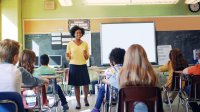SEL Begins With the Teacher
How teachers can use social and emotional learning to help middle school students build confidence.
Your content has been saved!
Go to My Saved Content.Many middle school teachers find success using extrinsic reward systems to manage class behavior, but these methods can cause a “What’s in it for me?” attitude among students when they’re asked to do something they should be doing anyway, such as being kind to others. A more intrinsic way to improve class behavior is to use social and emotional learning (SEL) to help students strengthen their relationships with teachers and peers.
SEL skills are also essential for student self-motivation. Although there was some resistance from students to do their schoolwork before the pandemic, COVID exposed more of that resistance. It stripped away the extrinsic factors that were in place in school systems, leaving students to motivate themselves. Teachers hadn’t taught executive function skills, however, and students were accustomed to being told what to do and how to do it. Students didn’t know how to manage time, so how could they motivate themselves and finish their assignments?
Here are some steps teachers can take to strengthen their own SEL skills so they can help students build the confidence and self-esteem to get their work done, and improve class behavior as a whole. These skills and concepts transcend middle school and can apply to elementary and high school students as well.
SEL and Teacher-Student Connections
Teacher-student relationships greatly impact learning, and focusing on the teacher role in SEL can lead to improved student academic performance. A lack of teacher training and comfort with SEL, however, means that student behavior and emotions can remain under the teacher’s radar. Here are some examples:
- A seventh-grade student, Steven, isn’t getting his work done because he’s afraid of not having the right answer and not pleasing his teacher. He freezes up and doesn’t do the assignment.
- A sixth grader, Miguel, does all he can do on an assignment and writes on his homework, “This is the best I can do,” which the teacher had suggested he write when he was stuck. The teacher, however, responds, “I don’t want to hear that.” Miguel is stunned and ashamed, so he may be less likely to speak up and advocate for himself.
- Penny, an eighth grader, has short-term memory loss due to previous traumatic experiences. After giving long verbal instructions, the teacher asks Penny to repeat them. Penny responds, “I don’t remember.” The teacher gets frustrated at having to repeat the instructions, and Penny feels ashamed and hurt. Rather than realizing it may be helpful for Penny to have written directions she can refer back to, the teacher gets angry.
Teacher attitudes and student experiences like these can influence student self-esteem and confidence when it comes to turning in assignments, and these patterns can last for years if left undetected. SEL must begin with teachers; the more teachers use their own SEL skills in the interactions they have with students, the more students will feel liberated to do the same.
A large part of promoting SEL is encouraging emotional expression, and this includes more than a check-in involving a thumbs-up or thumbs-down from students. If students know the classroom isn’t typically where they “do” emotion, then many will just give a thumbs-up because it’s the safer option, which defeats the whole purpose of a check-in. An SEL moment might be resisting the urge to call out a disruptive student in class or sending them to the principal's office, opting instead to do five minutes of deep breathing with the entire class.
Teacher SEL Training
Self-reflection is an important tenet of social and emotional learning, enabling teachers to practice their own self-care and promote well-being. When there are problems in the classroom or with others, it’s vital that teachers reflect on the part they may be playing. So, taking time to reflect on our role in problems we may have in our relationships with students can bring us greater awareness as to how we might change our strategies in the future.
Being self-aware is only one part of the SEL puzzle and overlaps with other SEL components, such as self-regulation. When we’re frustrated or angry, students know it, and they may have a hard time asking for help. Determining ways to tame our anger can also be a part of the self-reflective process that can go a long way in strengthening our relationships with students. These skills can help teachers throughout their career.
Here are a few questions that teachers can ask themselves to prevent further teacher (and student) turmoil:
- How can I make the work I assign meaningful to students?
- What is my role in why students aren’t getting their work done?
- How can I spend my time differently to get the results I want from students?
Considering all the tasks that teachers have to fulfill, it can be easy to reach for blame instead of self-reflection. This is especially true when students present challenging behaviors. Rather than raising our voices at students or calling out students in front of others, a better option would be to pause and think of other choices we have. Self-reflection can help us regulate our own behavior so that we can cultivate and prioritize a more caring way to interact with students. The benefits for both teachers and students will be long-term.
